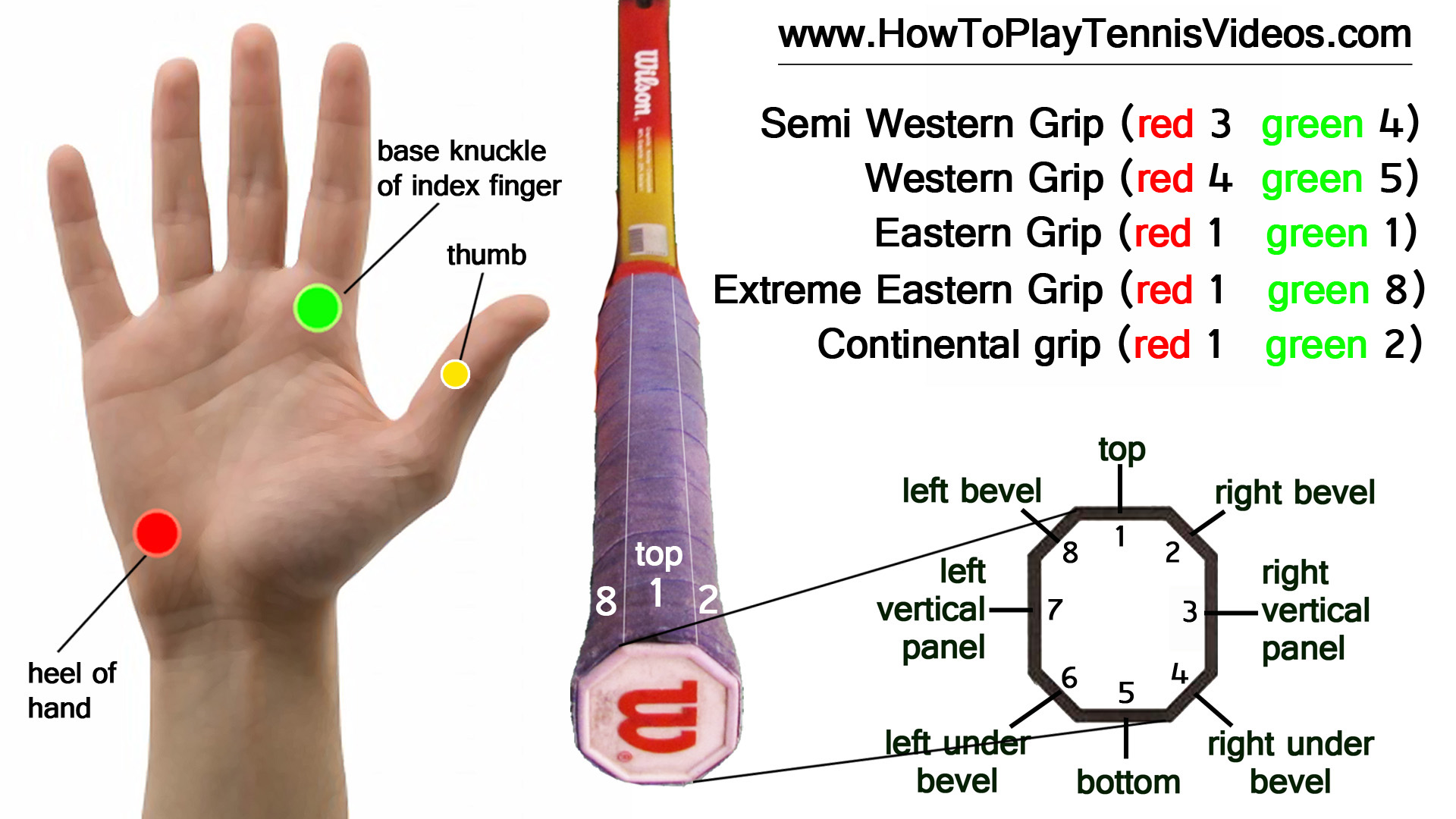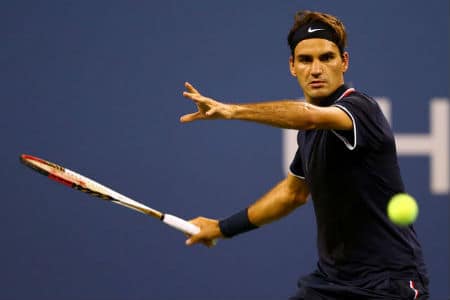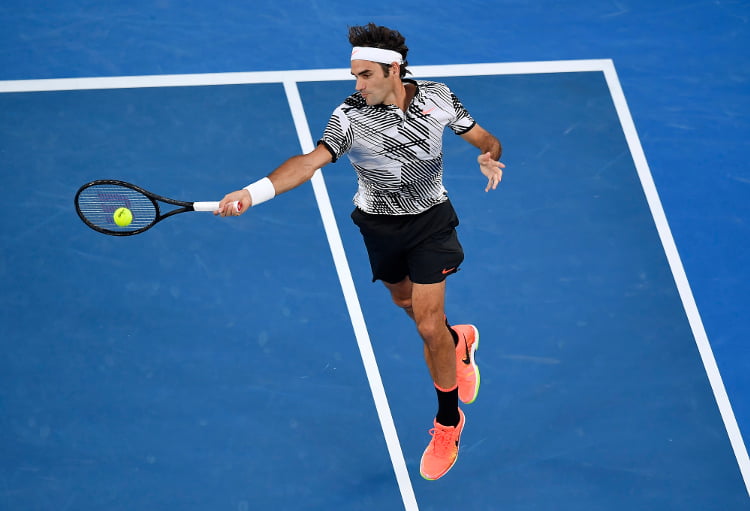Roger Federer has perhaps one of the most elegant forehands on tour, but behind the grace and elegance of Federer’s forehand – there are actually very distinct elements in Federer’s forehand technique that separates his forehand technique from players at all other levels of the game. While many commentators remark on Federer’s forehand which is adaptable, explosive & fluid,few coaches have been able to explain these technical elements much yet model these techniques behind Roger Federer’s forehand.
The Secrets Behind Roger Federer’s Forehand Technique
Roger Federer’s forehand is actually a very technically sound but yet simple & smooth stroke. Much to the surprise of many, Federer’s forehand is not difficult to model. Even club players and aspiring college and junior players alike can learn from Federer’s forehand to improve their own forehand technique. To begin, we will cover the elements of Federer’s forehand from the grip & preparation to the follow through of the stroke.
Roger Federer Forehand Grip


To begin, Federer’s forehand grip starts out with a conservative Eastern grip. Unlike many players in the modern game who advocate using the Semi-Western or even Full Western (like Rafael Nadal’s forehand), Federer’s forehand grip is actually quite conservative in today’s modern game of tennis. This eastern grip allows Federer to drive through shots more, while still producing adequate topspin for the “heavy ball” effect we will describe later on. This perhaps provides Federer the greatest amount of versatility and a blend of both topspin & power on his forehand.
Federer’s Forehand – Unit Turn


The unit turn in tennis is a key hallmark position behind the forehands of all top pro players on tour in the modern forehand. The “unit turn” as it is commonly called is a unitary body motion where the upper and lower body turns as one unit to initiate the preparation of the stroke. This means the focus is turning (or pivoting) the upper body and hips sideways as one unit, rather than just merely taking the racket back in a backswing independently. The key is all of the elements in Federer’s forehand starts out with him lowering his center of gravity and pivoting his right dominant foot and hips side ways and then allowing his shoulder to turn – which naturally brings the racket back.
This unitary body turn allows Federer to utilize the kinetic chain in his forehand, allowing the larger muscle groups to store passive energy later to be used to uncoil onto his shots. Most club players make the mistake of immediately taking a racket backswing without a proper unit turn. This will lead to a disconnection in the kinetic chain and poor power on the forehand.
Roger Federer’s Forehand Takeback & Backswing


The next key position to notice about Federer’s forehand after the unit turn has taken place is how Federer cradles the throat of his racket with the non-dominant hand and then initiates the takeback with the elbow leading. Federer keeps the racket backswing on the same side of his body, which allows him to take balls on the rise – and rarely gets caught hitting late. In the ATP style forehand, players do not extend the racket backswing behind the plane of their body unlike many WTA players ala Azarenka, Williams Sisters, etc…
This relatively compact swing allows Federer to be versatile in all areas of the court as an all-court player, unlike some less efficient swings where an elongated swing may cause a player to hit late on certain occasions.
Gravity Drop
Once Federer reaches the height of the takeback, he lowers the racket below the level of the incoming ball via gravity. There is no forced or wristy motion here. At this stage of the swing, Federer’s maintains a closed racket face angle which allows him to rapidly brush up behind the ball to create the windshield wiper forehand. Notice here, how Federer does not consciously exert any effort in the lowering of the racket, but gravity alone allows him to lower his racket whilst maintaining the correct hitting arm structure.
Hip Uncoil & Wrist Release
Federer’s forehand involves virtually perfect use of the kinetic chain. After the gravity drop is complete, Federer uncoils & opens his hips which brings his racket and wrist through and forwards into the contact point. Note here, that Federer’s hips are the driving force, causing the wrist to release and correct itself into the hitting arm slot. This motion is like a Nascar driver going from 0-60 MPH. The hips play a huge role as a the driver of the uncoiling motion, like the crack of a whip.
Commentators also note how Federer’s forehand appears “wristy” making him prone to injuries. Although his forehand appears wristy to the outside observer, there is almost no conscious manipulation of the wrist at this point. Federer is clearly fully relaxed and letting his body and racket do all the work in the kinetic chain. He almost never gets injuries, which is a testament to the efficiency of Roger Federer’s forehand.
Contact Point


Roger Federer’s forehand contact point is virtually flawless. Due to his impeccable timing, he is rarely caught off balance. His contact point is comfortably well out in front, with his hitting arm slightly bent or completely straight. Federer often utilizes a straight arm forehand contact point, whereby his elbow and arm is completely straight at contact. Other times, observers can find Federer’s hitting arm structure in the normal double-bend hitting arm position. Both are acceptable hitting arm structures – as long as players are using proper weight transfer and hitting the ball comfortably in front and not caught late or off balance.
Roger Federer’s Forehand Windshield Wiper Follow through


Once the contact point is complete, Federer rapidly brushes the ball in a windshield wiper motion. The windshield wiper follow through motion is synonymous with the modern forehand in tennis. This is a commonality amongst all top pro players in the ATP & WTA. Notice how Federer’s racket face transjectory forms a “rainbow” like arc as he completes the follow through.
The actual motion appears similar to the windshield wiper blades of a car, hence the term windshield wiper forehand. The key here is that Federer’s shoulder and upper arm is powering the windshield wiper forehand follow through, and not just the wrist alone. This is another common mistake some players make, is that they try to “wrist” the follow through artificially creating a weak ball, rather than allowing the upper arm to take control of the entire follow through motion.
Conclusion – Roger Federer’s Forehand Can be a Key Model for Players At All Other Levels of the Game
While many coaches and players often suggest that Federer’s forehand is too dangerous or difficult to emulate for the average player – Roger Federer’s forehand actually contains certain unique commonalities with all other top pro forehands on tour that are easily seen in slow motion. These unique commonalities are the EXACT elements that aspiring players can emulate and model to achieve better results on their forehand. While Federer does possess great natural talent, it is definitely possible for players at all other levels of the game to learn from Federer’s forehand technique
Learn to Hit a Forehand Like Roger Federer
If you want to jumpstart your forehand and play like the PROS, check out my 70+ page Tennis Ebook that will immediately show you how you can take your forehand to the next level.
The Modern Forehand Domination Ebook is guaranteed to improve your tennis technique, and increase power, topspin and accuracy of your tennis forehand!
Modern Tennis Forehand Ebook
Learn How to Hit a Forehand Like Federer, Nadal and Djokovic

